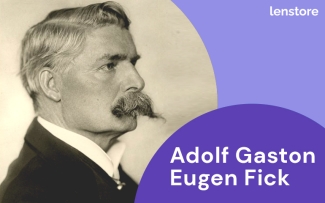Notable figures in eye care – Adolf Fick
Adolf Gaston Eugen Fick – (1852 - 1937)
Adolf Gaston Eugen Fick was an ophthalmologist who was a crucial figure in the development of contact lenses. Born in Marburg, Germany, in 1852, Fick had an unfortunate start to his life as both his parents passed away before his 6th birthday. Following the deaths of his mother and father, he was raised by his namesake uncle – Adolf Eugen Fick, a revered physician, physiologist, and cardiologist at the time.
Under the tutelage of his uncle, Adolf Fick (the younger) pursued his studies of medicine and anatomy in Germany and Switzerland, earning his doctorate in 1875. Fick then emigrated to South Africa, where he opened and operated a medical practice for seven years. Missing his homeland – Fick returned to Germany in 1886 and married Marie Wislicenus, daughter of well-known chemist Johannes Wislicenus. The couple moved to Switzerland, where he became a private physician and lecturer at the University of Zurich from 1887 to 1914.
Following the outbreak of World War I, Fick volunteered to work on the frontline at field hospitals across Europe while also progressing his work on ophthalmology and vision. In 1937, Adolf Gaston Eugen Fick died peacefully at age 84.

Adolf Fick’s contributions to eye care
- In 1888, Adolf Fick constructed the first scleral contact lens model by creating a shell-shaped lens made from blown glass to correct refractive errors.
- He trialled the first contact lens design by fitting the lens on the less sensitive tissue surrounding the cornea. First on rabbits, then himself, and ultimately on a group of willing colleagues.
- Fick published his findings under the title ‘Contactbrille’ in a reputable medical magazine, describing the first clinical use of contact lenses.
Final word
Adolf Gaston Eugen Fick is widely considered the inventor of the first true contact lens. Even though it was impractical to use for more than a few hours due to its weight and size, Fick’s work inspired other optical innovators to advance the design of contact lenses. Most notably, William Feinbloom, who created a lighter weight and more comfortable lens using a hybrid of glass and plastic.



